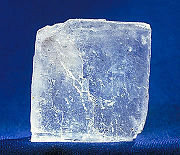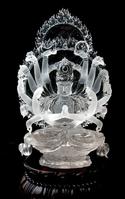Crystal发表评论(0)编辑词条
A crystal or crystalline solid is a solid material whose constituent
atoms, molecules, or ions are arranged in an orderly repeating pattern extending in all three spatial dimensions. The scientific study of crystals and crystal formation is crystallography. The process of crystal formation via mechanisms of crystal growth is called crystallization or solidification.
The word crystal is derived from the ancient Greek word κρύσταλλος (krustallos), which had the same meaning, but according to the ancient understanding of crystal. At root it means anything congealed by freezing, such as ice. The word once referred particularly to quartz, or "rock crystal".
Most metals encountered in everyday life are polycrystals. Crystals are often symmetrically intergrown to form crystal twins.
The process of forming a crystalline structure from a fluid or from materials dissolved in the fluid is often referred to as crystallization. In the ancient example referenced by the root meaning of the word crystal, water being cooled undergoes a phase change from liquid to solid beginning with small ice crystals that grow until they fuse, forming a polycrystalline structure. The physical properties of the ice depend on the size and arrangement of the individual crystals, or grains, and the same may be said of metals solidifying from a molten state.
Which crystal structure the fluid will form depends on the chemistry of the fluid, the conditions under which it is being solidified, and also on the ambient pressure. While the cooling process usually results in the generation of a crystalline material, under certain conditions, the fluid may be frozen in a noncrystalline state. In most cases, this involves cooling the fluid so rapidly that atoms cannot travel to their lattice sites before they lose mobility. A noncrystalline material, which has no long-range order, is called an amorphous, vitreous, or glassy material. It is also often referred to as an amorphous solid, although there are distinct differences between solids and glasses: most notably, the process of forming a glass does not release the latent heat of fusion.
Crystalline structures occur in all classes of materials, with all types of chemical bonds. Almost all metal exists in a polycrystalline state; amorphous or single-crystal metals must be produced synthetically, often with great difficulty. Ionically bonded crystals can form upon solidification of salts, either from a molten fluid or when it condenses from a solution. Covalently bonded crystals are also very common, notable examples being diamond, silica, and graphite. Polymer materials generally will form crystalline regions, but the lengths of the molecules usually prevent complete crystallization. Weak Van der Waals forces can also play a role in a crystal structure; for example, this type of bonding loosely holds together the hexagonal-patterned sheets in graphite.
Most crystalline materials have a variety of crystallographic defects. The types and structures of these defects can have a profound effect on the properties of the materials.
Properties
| Crystal | Particles | Attractive forces | Melting point | Other properties |
| Ionic | Positive and negative ions | Electrostatic attractions | High | Hard, brittle, good electrical conductor in molten state |
| Molecular | Polar molecules | London force and dipole-dipole attraction | Low | Soft, non-conductor or extremely poor conductor of electricity in liquid state |
| Molecular | Non-polar molecules | London force | Low | Soft conducter |
水晶的化学成分及性质:
水晶是一种无色透明的大型石英结晶体矿物。它的主要化学成份是二氧化硅,跟普通砂子是“同出娘胎”的一种物质。当二氧化硅结晶完美时就是水晶;二氧化硅胶化脱水后就是玛此为水晶原生矿,金发晶品种瑙;二氧化硅含水的胶体凝固后就成为蛋白石;二氧化硅晶粒小于几微米时,就组成玉髓、燧石、次生石英岩。
化学式为SiO2。纯净的无色透明的水晶是石英的变种。化学成分中含Si—46.7%,O—53.3%。由于含有不同的混入物或机械混入的而呈多种颜色。紫色和绿色是由铁(Fe2+)离子致色,紫色也可由钛(Ti4+)所致,其他颜色由色心所致色。在水晶中含有砂状、碎片状针铁矿、赤铁矿、金红石、磁铁矿、石榴石、绿泥石等包裹体;发晶中则含有肉眼可见的似头发状的针状矿物的包裹体形成。含锰和铁者称紫水晶;含铁者( 呈金黄色或柠檬色 )称黄水晶;含锰和钛呈玫瑰色者称蔷薇石英,即粉水晶;烟色者称烟水晶;褐色者称茶晶;黑色透明者称为墨晶。
水晶另一脾性就是怕碱不怕酸(氢氟酸除外),这是由于氧化硅特性所决定的。
k9水晶,是一种含铅的人造水晶,起亮度比普通水晶要亮,是目前质量最好的人造水晶.
水晶的物理性质
1824年,一位叫弗里希.摩斯的奥地利矿物学家,从许多矿物中抽出10个品种,经过科学实验测出它们的相对硬度,由此得出水晶硬度为摩氏7。尽管后来美国国家标准局使用、推广更科学的诺普硬度测试器,但世界上许多国家的珠宝商,仍习惯于摩氏硬度表。
结晶完美的水晶晶体属三方晶系,常呈六棱柱状,柱体为一头尖或两头尖,多条长柱体连结在一块,通称晶簇,美丽而壮观。二氧化硅结晶不完整,形状可谓是千姿百态。当你到海南水晶陈列馆去瞧一瞧,可以大开眼界:除了常见的长柱状外,还有似宝剑形,有的若板状,有的如短柱形,有的像双锥。有的小如手藏宝图-水晶指,有的大如巨石;有的不足半两,有的重达300多公斤。
水晶呈无色、紫色、黄色、绿色及烟色等。玻璃光泽。透明至半透明。硬度7。性脆。比重2.65。无解理。贝壳状断口,也有好的平等脊的人字形断口。紫水晶具有清楚的二色性,黄水晶和茶水晶具有弱的二色性。发光水晶具有强烈的磷光性。带绿色的砂金水晶在长、短波紫外线照射下发灰绿色荧光。具有猫眼、虹彩和砂金效应。水晶具压电性.
水晶晶体结构及形态
属三方晶系。晶体呈棱柱状并带六边形锥,柱面有横纹,紫水晶中常有角状色带。在自然界中,水晶常呈晶簇产出,造型美观。
结晶完好的水晶,常有好的平行脊的人字形断口;在紫晶和热处理的黄晶中,多呈不平坦到薄片状破口。
水晶比重:2.56-2.66克/立方厘米。
这意味着一定体积水晶的重量,是相同体积水的重量的2.56-2.66倍。块状变种水晶密度可能稍高些。
水晶条痕:无色。
条痕,通常说的颜色,是人眼对一定波长的光线感觉的结果。
水晶透明度与透过它的光的质与量有关。透明标准为:光线透明过厚度为1厘米以上的水晶碎片或薄片时,可以清晰地看到映出的图像。如是底像不够清楚,仅见轮廓,那便中半透明。
水晶光泽:玻璃光泽。无论在抛光面上还是在破口都是如此。
光泽,指宝石表面对光线反射的一种光学性质。水晶既不像星光蓝宝石和星光宝石那样反射出绮丽的星光形条纹,又不像月光石那样发出淡蓝色波形光彩,更不像乘欧泊石那样闪烁着五颜六色。
观察水晶的光泽,可用手握着它,以灯光或窗户投进来的光线看表面反射,透明水晶亮度与光泽强弱有关。
水晶折射率:1.544-1.553,几乎不超出此范围。
折射率,是当光由空气中透入宝石晶体,并产生折射现象,其入射角正弦与折射角正弦之比值。
水晶重折射率:0.009(最大),此值非常稳定。
水晶光性特征:一轴晶正光性。
水晶色散:0.013。
色散是说宝石的折射率随照明光的不同而有一定的变化。例如钻石对红光折射为2.405;对绿光为2.427;紫光为2.449。
水晶熔点为1713摄氏度。其受热易碎的特性,是在实验时发现的。将水晶放在喷焰器的烈焰燃烤,除非有很好的保护,且慢慢冷却,否则晶体容易碎裂。这一脾性,古人已摸透。博物要览提醒道:“凡用水晶器物,不可用热汤滚水注之,即粉裂如击破者。"
与“crystal,水晶”相关的词条
→如果您认为本词条还有待完善,请 编辑词条
词条内容仅供参考,如果您需要解决具体问题
(尤其在法律、医学等领域),建议您咨询相关领域专业人士。
0

同义词: 暂无同义词
关于本词条的评论 (共0条)发表评论>>









